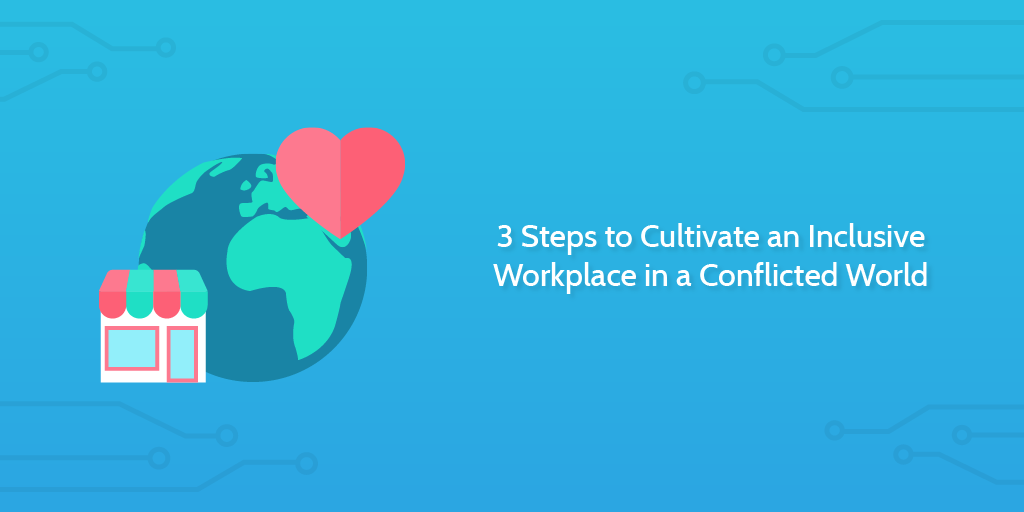 This article is a guest post from Wendy Dessler; a super-connector who helps businesses find their audience online through outreach, partnerships, and networking. She frequently writes about the latest advancements in digital marketing and focuses her efforts on developing customized blogger outreach plans.
This article is a guest post from Wendy Dessler; a super-connector who helps businesses find their audience online through outreach, partnerships, and networking. She frequently writes about the latest advancements in digital marketing and focuses her efforts on developing customized blogger outreach plans.
It’s easy to check a few boxes when it comes to backgrounds and ethnicities, but does that really equal inclusivity?
Let’s face it, these are conflicted times. Everything seems to be coming to a head, and as workforce leaders, we need to make it a priority to make sure people feel valued.
Diversity is more than just a buzzword.
Diverse companies have a better reputation, and they also reap the endless benefits of having people from a variety of cultures, experiences, and backgrounds. Even if you don’t think inclusivity and diversity is a real issue today, it is.
An unfortunate 44 percent of managers are “too busy” to bother with diversity initiative. Including more people and encouraging a variety of perspectives does take time. It’s not always easy. It’s a team effort in many ways, yet it’s so essential to success today.
It’s not all about diversity. It’s also about building a culture of respect and appreciation.
We’ve all experienced working somewhere where we didn’t feel welcome. Maybe the leaders were too harsh and demanding. Maybe the hours were ridiculous. These jobs aren’t worth keeping, and they cause employees to feel undervalued.
You work hard to bring the best talent into your company. Don’t you want those individuals to feel excited about where they work? Believe it or not, it’s hard to find top talent today. According to the ManpowerGroup Talent Shortage research, 45 percent of employers across the globe struggle to find the skills they need. This is the highest in over a decade.
It’s time for your company to thrive thanks to different perspectives, skills, and personalities. Give your top performing employees a reason to love working at your organization.
If you’re ready to create an inclusive environment built for thriving, keep reading this Process Street article to explore the top 3 steps for cultivating diversity, inclusivity, and more.
Step 1: Form an Inclusion Council

Your company might need a group of dedicated individuals who can hold the entire business accountable for inclusivity. These should be leaders who have been chosen because of their dedication to inclusion and their passion for people. These are people who should be excited to put in the work to change the workplace environment.
Your council can be as few or as many people as you feel works for your organization. These members should set clear hiring goals, retaining current workers, and tackling any problems with poor representation. Your council can meet regularly, whether that means monthly or quarterly, to present any feedback for any other leaders.
It goes without saying, but your council should be as diverse as possible. This includes not only different ethnicities, but also different genders, leadership levels, and backgrounds. Diversity is something 57 percent of employees want from their employers. New experiences and perspectives keep organizations fresh and light on their feet.
However, don’t put the pressure of diversity only on those in underrepresented groups. It is everyone’s responsibility to make positive changes towards inclusivity. This should be a council of enthusiastic, excited volunteers who are willing to take on this challenge.
Welcome their discussion. Listen to their feedback. Many of the problems that arise in your council are indicative of larger problems brewing in the company. You need to take them seriously if you want a serious change.
Actionable Steps
- Identify motivated and passionate leaders
- Form a council of 6-12 individuals who are ready to fight for progress
- Create a plan for meeting regularly and assessing changes within the organization
- Analyze your success moving forward
Step 2: Encourage Differences

It’s easy to fall into the trap that differences lead to more conflict. Managers fear that people who have different backgrounds, educations, and perspectives might not agree on the day to day tasks. Along these lines, this conflict will slow employee productivity. This thinking holds managers back from making the push for diversity.
MIT’s cognitive intelligence study discovered that diverse teams actually outperform non-diverse teams by 35 percent. The teams comprised of a variety of races and genders were most successful at communicating and had higher levels of sensitivity towards each other.
Employers can demonstrate that they respect their employees by encouraging differences. It can be as simple as holding a company-wide potluck and having everyone bring a dish that’s special to them. On the other hand, it might involve larger changes like offering a meditation or prayer room to accommodate different belief systems.
People need to feel they’re able to be their full selves at work. Nobody wants to hide who they are or what they believe, so why make a workplace that encourages people to stay within their mental confines? Even small steps have a big payoff for companies. Diverse teams are better at making decisions, and they lead to more innovation. Nobody got anywhere by refusing to change.
Inclusivity means welcoming differences. Workspaces that encourage people to bring their differences and celebrate them can see more improvement. People will not only be happier to work in a place that’s welcoming to them, but you’ll feel more connected as a company. This is an effective way to keep your top employees in your organization as long as possible.
Diverse teams earn more money. Gender-diverse companies are 15 percent more likely to earn above-average revenue. This is likely because they’re able to take advantage of more perspectives. Having more angles to put in place when you’re tackling business issues helps produce faster results, creative thinking, and more cash for the company.
Why wouldn’t you want more revenue and success as a business? If all it takes is welcoming greater perspectives and understanding, why wouldn’t you welcome this change? Yes, it takes hard work. Yes, there might need to be some minor to large company-wide changes. However, the payoff is more than worth it. In fact, you can’t afford not to prioritize inclusivity.
Actionable Steps
- Work with your council to discuss important changes within the company
- Create a culture of diversity, positivity, and welcomeness
- Start initiatives to bring more diverse candidates into your workplace
Step 3: Listen to Your Employees

Finally, the last and arguably most important step is to listen to your employees. Your workers all have a perspective and unique experiences. Unless you’re talking with them regularly, how will you know what these experiences are? Many leaders make the mistake of thinking they understand the way their employees feel, yet this generally isn’t the case. Don’t make assumptions about the lower to mid-level employees experiences.
We all want coworkers who feel like family. Like with family, you need to communicate in a healthy way. You need a platform for speaking openly and without judgment. Yes, you want a diverse, welcoming space. But, more importantly, you want a healthy, inclusive workplace.
Meetings and employees reviews aren’t enough to break down these walls. Instead, there needs to be a deep cultural shift in the entire organization. Very few positions are “solo” positions. People are working together on a daily basis. How can you make sure those people feel heard, valued, and appreciated?
When you don’t listen to employees, they feel like just another cog in the wheel. Believe it or not, 79 percent of people who quit their jobs do so because they feel underappreciated. Think about it this way, people aren’t leaving companies, they’re actually leaving their bosses. This just demonstrates the power of positive, healthy leadership and communication.
How do you begin to tackle communication? Start with trust. Building trust sounds simple, but this takes time. You need to create a way to delegate tasks, stop micromanaging, and receive feedback regularly. Remember, feedback is a two-way street. Employees and managers alike should be open to feedback. This shows employees that their managers appreciate their perspective and that they’re taken seriously as members of the company.
The Harvard Business Review discovered that 58 percent of people trust strangers more than their own boss. Even if you think your employees trust you, it might be time to check for yourself. Trust has to be earned, so don’t assume you already have it when you haven’t worked for it.
Let’s talk real-life ways to build trust and encourage listening since this is the most important step after all. Try these tasks below to see how they pay off in big ways for your organization:
- Names – You should be a person first and a manager second. If you’re seeing those in front of you as employees and not fellow human beings, it’s time for a shift.
- Actions – It’s no surprise that actions speak louder than words. Listening effectively means asking the right questions that go beyond the surface. Then, follow up this conversation with real action. Follow through on the things you say.
- Allow Failure – Employees can tell when a leader feels threatened. Accept failure as what it is, a learning experience. Don’t feel intimidated by success, especially when it’s from a member of your own team. Failure is just another way to grow.
- Flexibility – Show your employees you trust them to work when it makes the most sense for them. The 9-5 workday is falling out of practice, and this is something to celebrate. Find more info on flexible scheduling to decide if it’s right for your workplace.
- Open Doors – Enact an open door policy for employee concerns, questions, and problems. This might be as literal has having your office door open several times a day, or just regular meetings.
When your employees feel you trust them, they’ll trust you back. This trust builds relationships that last. While you don’t have to be friends with your employees, they need to understand they aren’t just a cog in the wheel of your organization. Start small and build up until you’ve created a space where your employees always know they can come to you and speak openly.
The world is conflicted enough. Don’t make your employees’ workdays conflicted as well. Keep your top talent satisfied and motivated. It’s time to stop overlooking conflict, problems, and misunderstandings.
Actionable Steps
- Create a system of regular informal meetings with your employees to build trust
- Allow flexibility in the workplace
- Take employee perspectives seriously
Use Process Street to make sure your policies bring results
Process Street helps you make sure things get done.
By creating actionable business processes for recurring tasks you can make sure things happen the way they were intended to happen.
Process Street is a comprehensive workflow management software which lets you build templates of your processes and run them as checklists.
You could make processes for the meeting structures of your inclusion council or for running regular employee feedback sessions.
By systemizing your inclusivity efforts, you’re able to tie them in formally to the way your business operates, rather than letting them become an after thought which gets pushed aside whenever anyone gets busy.
With features like conditional logic, stop tasks, and task assignments you can build the right processes for running your team.
Diversity and an inclusive workplace is good for business
Don’t be blind sighted by diversity in the workforce. The world is complicated. Your employees are as well. Don’t look for one-size-fits-all workers who offer nothing new. You want the best talent, and that means recruiting a variety of individuals of different backgrounds to represent your company. You want to free yourself of any restrictions that holds your business back.
Glassdoor discovered 67 percent of people consider diversity as one of the top factors when choosing an employer. If you want to create innovative solutions for tomorrow, you need to invest in diversity and inclusivity today. Once again, this isn’t a bingo card you check off with different ethnicities and genders. It’s an initiative to bring perspectives together that span across boundary lines.
If you put ten people with the same background together in a room, they’ll come up with the same solution. If you mix a diverse group of people together, who knows what you’ll come up with? In this day and age, you need to find new ways to innovate and push beyond what’s considered “normal.”
EY’s global study found that those who trust their leaders within their organization are happier at work, stay with the company longer, and do higher-quality work. We’ve all experienced leadership we don’t trust. Don’t allow that to become commonplace in your workplace. We can all do better, and we need to.
As we welcome a new generation of workers, inclusivity and trust becomes more essential than ever before. When employees feel their leaders trust and respect them, they’re 63 percent more satisfied with their position. Though seemingly simple, trust is truly the currency of business.
Are you ready to create a successful, future-proof organization that attracts (and keeps) the best talent? If so, it’s time to take these steps above seriously. You can’t afford it to overlook the condition of your workplace. Fight back against the conflict facing our world today by making your workplace an inclusive, positive space for all.
How do you manage workplace inclusivity? What strategies have you found to be successful? Let us know in the comments below!







 Workflows
Workflows Projects
Projects Data Sets
Data Sets Forms
Forms Pages
Pages Automations
Automations Analytics
Analytics Apps
Apps Integrations
Integrations
 Property management
Property management
 Human resources
Human resources
 Customer management
Customer management
 Information technology
Information technology



Adam Henshall
I manage the content for Process Street and dabble in other projects inc language exchange app Idyoma on the side. Living in Sevilla in the south of Spain, my current hobby is learning Spanish! @adam_h_h on Twitter. Subscribe to my email newsletter here on Substack: Trust The Process. Or come join the conversation on Reddit at r/ProcessManagement.